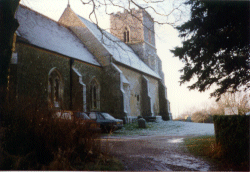 |
 |
Until 800 - 900, the villages were mostly served by
visiting Clergy sent by the Bishop. The first Rectors would have been appointed by the Saxon
Lord of the Manor who built the Saxon Church.
After the Danish and Norman
invasions, the Normans built a Church on the site, probably about the same time as the
Norman Castle was built - late 1000s or early 1100s, and being within the Castle bounds, it
probably served as a Garrison Chapel as well as the Parish Church but the earliest record
of the name "All Saints" is 1470.
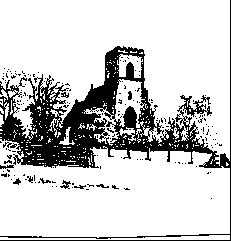
Alterations were made over the years, but before the l9th
century remodelling, the building was mostly 15th or 16th century. New windows were
installed in the Chancel in 15th century and the Nave was rebuilt, making it wider and
higher than the Chancel. The three storey tower looked short against the new posts upon tie
beams.
By 1615 there was a Rectory and between 1635 and 1724 this was rebuilt in brick, partly
with materials from the decaying mansion at the Castle.
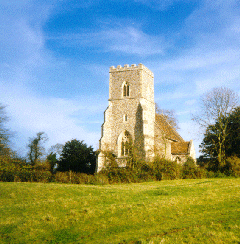
On March 20th 1643 during the Civil War, Dr. Gray was
ejected from the Rectory for supporting Charles lst and on March 25th 1643 the notorious
Will Dowsing destroyed the painted glass windows in the Nave and Chancel and broke the Cross
on the Nave roof.
About 1644 the Altar steps were levelled. The Altar rails with turned balasters were
reinstated, probably in 1660s.
A chimney was inserted in the Chancel in 1665.
The Lord Bishop of Ely is reported to have inspected the Church on September 9th 1685.
The Chancel screen still survived in 1744 but only the base remained in 1851.
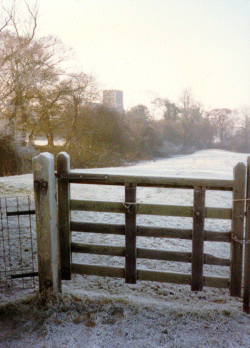
Early in the 19th century, a new ceiling was fitted to the
Chancel and an East window with cast iron tracery - perhaps about 1818 when the lead roof
was replaced by slates (themselves replaced in 1883).
The octagonal 15th century font was largely re-cut in 1850.
Some 14th century glass in the Nave's South windows was re-set in 1923.
The Choir stalls were inserted in 1883 and there was a robed choir as recently as
the 1950s.
The old Tower, built about 1400 in the decorated style of
architecture, collapsed in July 18th 1850. Norman remains were found in the tower which
seems to prove that this tower replaced a Norman one and that the present Church was built
some 50 years later than the fallen tower. The remains of two bodies were found under the
tower, one in a coffin of solid oak, and are believed to be of the Saxon period which would
seem to prove that "All Saints" stands on the site of one of the earliest Christian Churches.
The remains were carefully replaced under the foundations of the new tower which was
commenced in June 1851 and completed before the end of the year. It is built on a solid bed
of concrete and the walls, which average 4' thick, are about two-thirds solid brickwork. The
cost of this tower was £754 and the Architect was W.G.E. Pritchett of Bishops Stortford.
The Rev. George Pearson rebuilt the 15th century Porch in
1855 and in 1856 inserted new windows in the Chancel to replace the old wooden frames,
heightening the walls.
In 1882 the whole Church was thoroughly restored by J.P.
St. Aubyn. Stone tracery replaced the cast iron in the East Window and West gallery was
removed and internal woodwork entirely renewed.
The Nave's North windows were renewed in 1908 and its roof timbers mostly replaced in 1913.
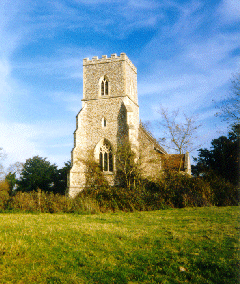
The Church plate in 1552 included 2 silver gilt Chalices
and Patens.
The Parish Magazine of June 1890, the plate was listed as "a silver paten (of 1684)
inscribed 'For the towne of Castle Camps. E.B.W. 1686' ", a cup inscribed 'Castle Camps,
Cambridgeshire, 1778', and a Flagon and Silver Dish 'Presented to the Parish of Castle Camps
by the Rev. George Pearson, B.D. Rector, 1846'.
In the 1960s, the Rev. Gibson had these locked away in a Safe Deposit.
The Church Registers begin in 1563 and are virtually
complete.
The average attendance at the services in 1851 was 170 plus 100 Sunday School pupils.
The old Rectory was requisitioned by the R.A.F. during the
Second World War and sold in 1952 when it was renamed 'Berghane Hall'.
The Parish has been run jointly with Shudy Camps (formerly
Little Camps) since 1945 but "All Saints" has remained the senior church. Charterhouse still
owned the advowson in 1974.
The Sunday School building adjoining the Church was
erected in July 1826.
The Tower contained 4 bells in 1552 of which one was riven
in 1596 and all four in 1744.
By 1826, 2 bells were split and in 1828 'in consequence of the bells being in a bad state
and some of the principal timbers being completely decayed, the Parish resolved to put up a
new peal'. 'The old bells were 4 in number and 2 of them were cracked and quite
unserviceable'.
The new peal of 5 bells was cast by Mr. William Dobson of Downham. This peal remained intact
until July 18th 1850 when the third bell was broken when the tower fell. This bell was
recast by Messrs. Taylor of Loughborough and the peal was rehung in the new tower in an
entirely new oak framework by Mr. Balls of Norwich, a Builder.
In the new tower, the ringing chamber, instead of being on
the same level as the Church floor, is at a considerable height, up above the West Window,
and is approached by a turret staircase from the outside.
In 1884 a chiming apparatus was fixed and in March 1886 the peal was taken out, the gudgeons
re-lined and turned, and new gun-metal bearings supplied, new tops put to the clappers and
wood pulleys and slider boards fixed and five new bell ropes. The bells were re-hung by
John Warner & Son of Crescent Foundary, Cripplegate, London, E.C.
In the summer of 1886 the ringing chamber was wainscoted
with matchboarding and ceiled and seats provided and the South Casement made to open.
Lord Grimthorpe (known to many as Beckett Denison, designer of the Westminster Clock and
'Big Ben') and other competent judges considered the bells to be one of the best peals of 5
in the country.
Those interested in the bells might also be interested to
know that the Downham Foundary was started in 1779 by Mr. Thomas Osborn who was already well
known as an experienced Church Bell founder. He acquired an extensive business which was
continued after his death in 1806 by his grandson, Mr. William Dobson. On the latter's
retirement in 1833, the business was purchased by Mr. Thomas Mears of the Whitechapel Bell
Foundary, London.
The chiming mechanism was put in order by the Friends of
All Saints Church, Castle Camps, and the bells rung for the first time for many years on
9th March 1980.
One noted rector was John Ernest Bode of 1860 who is
remembered as the author of the hymn He is buried in the church
yard near the hedge facing the West window.
This List was last updated on 17th November 2000.
The number of
people who've looked at this page so far is: